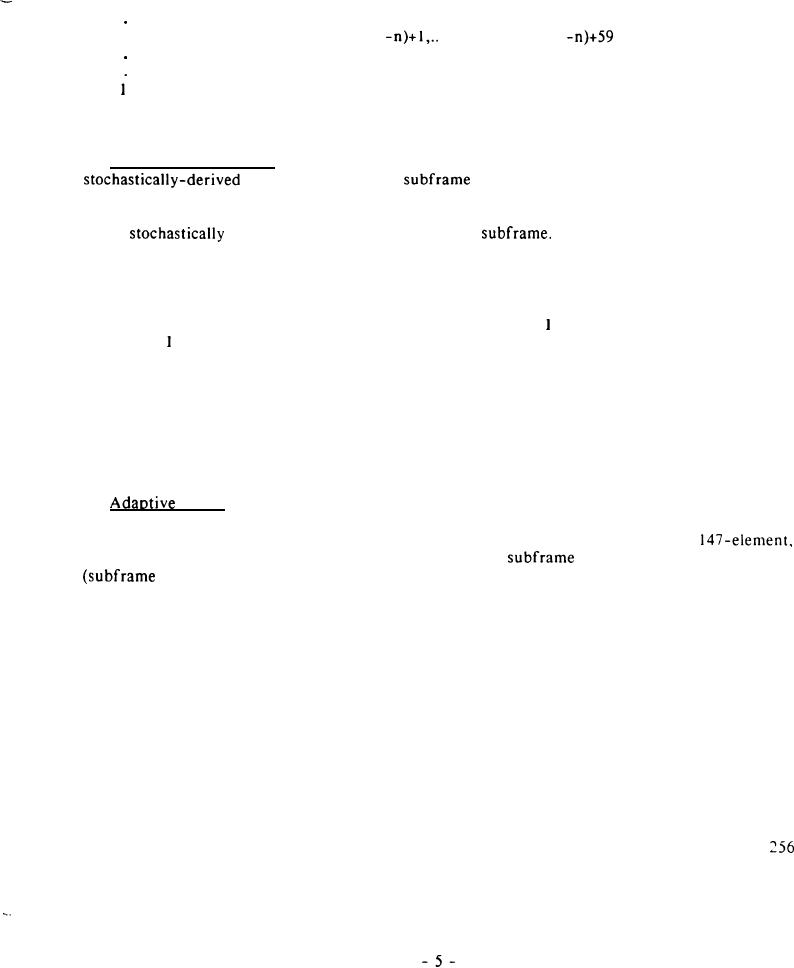
FED-STD 1016
Index
Elements In Codes
511
0, 1, 2,...
. . . . 58, 59
510
2, 3, 4,...
. . . . 60, 61
n
2(51 l-n), 2(511
. . . . 2(511
1,020, 1,021, 1,022,...
. . . . 1,078, 1,079
0
1,022, 1,023, 1,024,...
. . . . 1,080, 1,081
3.4 "Stochastic" Code Gain. The relative amplitude (to the nearest table value) to be applied to the
code elements of each
is determined during analysis and coded into
5 bits according to the following table. The decimal index number is then transmitted in binary form.
At the receiver, in voice synthesis, the gain index number is used to decode the relative amplitude
of the
- derived code elements during the
Index
Gain
Index
Gain
I n d e x Gain
Index
Gain
-178
o
-1,330
8
16
24
224
-870
-136
9
17
25
278
3
2
-660
18
13
10
98
26
340
3
-520
19
11
-64
418
35
27
4
-418
12
20
64
-35
28
520
5
-340
-13
13
21
29
98
660
6
-278
14
22
136
-3
30
870
7
-224
15
-1
23
178
1,330
31
3.5
Codes
3.5.1 Adaptive "Code Book" and Integer-delay Codes. The adaptive "code book" is a
shifting storage register that is updated at the start of every
with the previous 60 elements
interval) of Linear Prediction Filter excitation. Element ordering is such that the first
excitation elements into the Linear Prediction Filter are the first into the adaptive "code book".
Elements already in the storage register are shifted up during the update process and the oldest
elements are discarded. The 128 integer-delay overlapped adaptive codes, of 60 elements each, are
generated from the information in the adaptive "code book" as follows. Adaptive codes 60 through
147 are composed of elements -60 to -1, -61 to -2, . . . through -147 to -88, respectively (where
element -1 was the last element into the adaptive "code book"). Adaptive code "n", where n ranges
from 20 to 59, repeats the adaptive "code book" elements sequentially from -n to -1 to form a
60-element code. As examples, adaptive code 20 repeats adaptive "code book" elements -20 ...-1
three times and adaptive code 59's elements run -59 . . . -1, -59. Regarding order of utilization, the
most negatively numbered (i.e., most delayed) element of a particular adaptive code is used to
compute the first element in time of Linear Prediction Filter excitation for a particular subframe
period.
3.5.2 Noninteger-delay Codes. An additional 128 impli'tit, noninteger-delay codes, defined in
section 3.5.4, can optionally be made available through interpolation during voice analysis. All
adaptive codes shall be available for voice synthesis. Forty point interpolation, or the equivalent, shall
be used in both voice analysis and voice synthesis. (However, this does not preclude interpolating
with fewer points, perhaps as few as 8 points, during preliminary code search computations). The
process of interpolation is described in section 3.5.3.